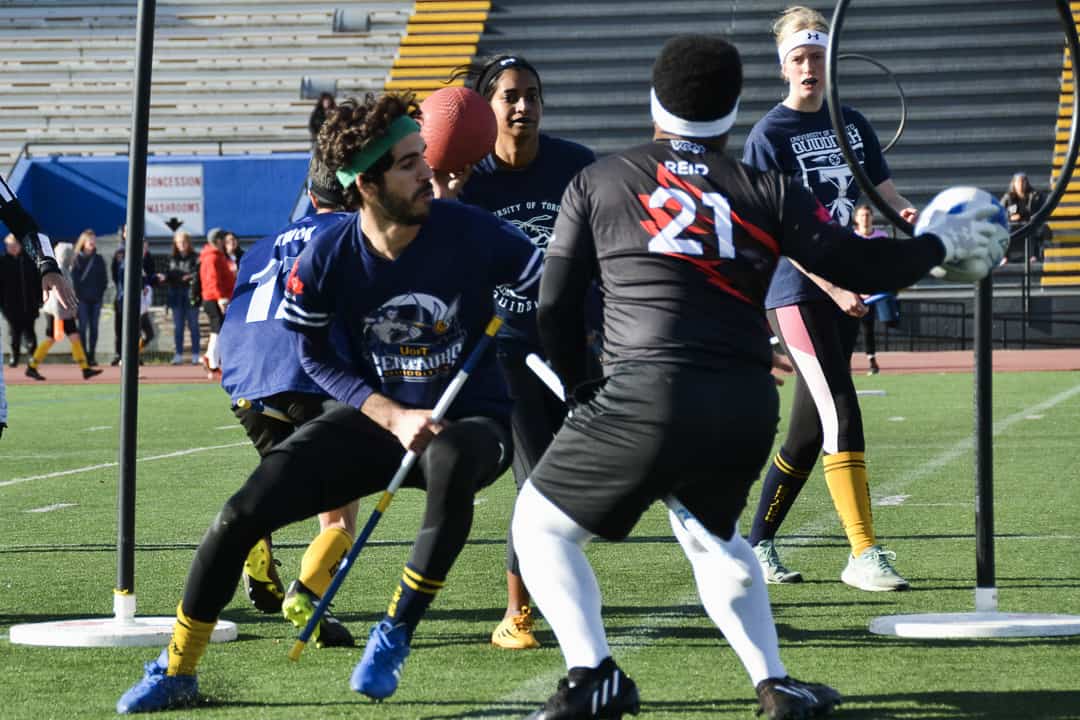The publication of JK Rowling’s Harry Potter and the Philosopher’s Stone in 1997 introduced the world to the sport of quidditch. A captivating narrative about flying wizards, magical brooms, and intense athletic strategies roped in readers for generations. The sport-inspired fantasies of flying and friendships strengthened through heated training sessions. But what if I told you that a club at the University of Toronto is bringing this imaginary sport to life?
Quidditch, no longer confined to the pages of a book, is a competitive sport across Canadian universities organized by Quidditch Canada. The Varsity interviewed Gabriel Kwok, the co-captain of U of T’s quidditch team, the Centaurs, to discuss how us ‘muggles’ play quidditch.
Quidditch can be complicated, but it becomes easier over time. The sport is a combination of rugby, handball, dodgeball, and basketball. To be in play, players are required to carry a PVC pipe, which is considered the broom, between their legs. Each team has three hoops designated for scoring. Players have specific positions, which include the chaser, keeper, beater, and seeker.
Chasers and keepers work together to score by throwing a volleyball into the opposing team’s hoops. Keepers receive a privileged row in the keeper zone. The beaters are tasked with using a dodgeball to knock out players on the other team. These dodgeballs are called bludgers. The last position of seeker comes into play 20 minutes after the game begins. Their task is to catch the snitch, which is a small ball carried by a designated referee wearing snitch shorts.
Running around on the pitch while dodging, catching, and throwing balls seems exhilarating. Flying may not be possible in our world, but compensating with energy, strategy, and a welcoming community sounds just about perfect.
However, due to recent controversies concerning JK Rowling, the North-America-based Major League Quidditch (MLQ) decided to rebrand the sport. According to an MLQ report published in July 2022 in collaboration with US Quidditch, the sport will now be called “quadball.” The International Quidditch Association also accepted this decision.
Gabriel explained that the name change provides an “opportunity to open up to sponsorships.” Over time, he expects the team to transition “out of the Harry Potter” and become a more “sports-oriented club.”
So how do you join the team? First off, there aren’t any requirements for players to have prior experience, due to the fact that quidditch isn’t a common sport. The team encourages inclusivity in opportunities, as Gabriel explained: “If you come to practice, we will let you into the roster” — a policy that exists to reward players who invest time into the team. The quidditch season primarily takes place over the fall semester. This year, the players participated in three tournaments at Western University — Quidditch eastern divisionals and central divisionals. Over time, the performance of the athletes has improved, with the Centaurs winning more and more matches.
Although participating in nationals will not be possible this year, since the date coincides with exam season during the winter term at U of T, Gabriel hopes for a brighter prospect for next year: “Next year, nationals will be in March so there’s… a higher chance for us to attend the tournament.”
Even though the U of T quidditch team might not attend nationals, individual players still have the opportunity to compete.
For any new players looking to join, Gabriel tells them, “Just do it… Do not be afraid of people thinking you are bad because you are learning.” He emphasized that “as long as you are good at receiving feedback” and “willing to learn,” it is likely you will get better.
Regardless of whether the sport is called quidditch or quadball, it’s an interesting new game with lots of exciting developments on the horizon.


